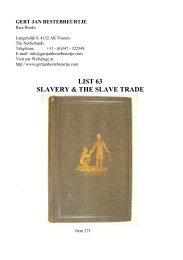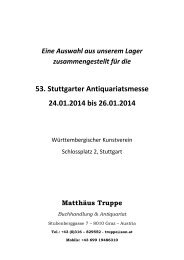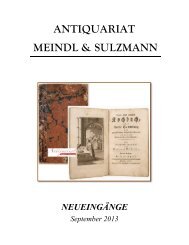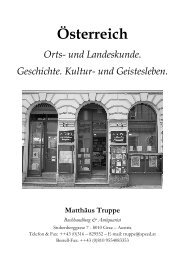Archives & Manuscripts #14 - International League of Antiquarian ...
Archives & Manuscripts #14 - International League of Antiquarian ...
Archives & Manuscripts #14 - International League of Antiquarian ...
Create successful ePaper yourself
Turn your PDF publications into a flip-book with our unique Google optimized e-Paper software.
9 (Dance). [Scrap Book]: Dance Marathon, Revere Beach, Massachusetts. $4500<br />
Large quarto. String-tied<br />
red leatherette boards with<br />
“Scrapbook” in gilt on<br />
front board. 38 pages <strong>of</strong><br />
photographs, souvenirs, and<br />
mimeographed newsletters<br />
for the Revere Beach Circus<br />
Marathon that took place<br />
in late 1933 and early<br />
1934. Acidic pages brittle<br />
and chipping, one or two<br />
are detached, but the<br />
contents are generally near<br />
fine. The dance marathon<br />
craze was a product <strong>of</strong> the<br />
late 1920s and early 1930s,<br />
fueled by the desire for<br />
spectacle and a surfeit <strong>of</strong><br />
available personnel during<br />
the Depression.<br />
This scrapbook was<br />
apparently kept by a fan<br />
who carefully tipped in<br />
or mounted material, mostly from<br />
a marathon in Revere Beach, Massachusetts. Also<br />
tipped in at the beginning is a nice copy (with wrappers detached) <strong>of</strong> Souvenir<br />
Booklet: The Dance Marathon, a forty page octavo illustrated pamphlet (Boston:<br />
Sherriff Press, no date-circa 1933) which was sold by the marathon dancers and<br />
reportedly remains one <strong>of</strong> the best sources on the marathon dance movement.<br />
Tipped-in are 23 legal-sized double-sided, mimeographed newsletters from<br />
the marathon, carefully tipped-in along the left margin thus making all the<br />
content readable (a couple <strong>of</strong> them are laid in). The bottom thirds <strong>of</strong> each <strong>of</strong> the<br />
oversized newsletters have been carefully folded, and have tiny tears and other<br />
folds, but are very good or better.<br />
The newsletters called Marathon News (or more cleverly Mararthonews) were sold<br />
for five cents per issue to benefit the contestants, and provided summaries <strong>of</strong> the<br />
previous days’ activities, accounts <strong>of</strong> couples dropping out, accounts <strong>of</strong> romance<br />
and strife on the dance floor, descriptions <strong>of</strong> difficult dance maneuvers concocted<br />
by the judges to precipitate couples dropping out, and an ever-changing table <strong>of</strong><br />
odds <strong>of</strong> success for the various dancers. The first number (Volume One, Edition<br />
One) dated August 8, 1933 announces: “Unusual Feature! Next Wednesday.<br />
A Real Live Baby To Be Given Away Free” and further “Oh yes you can rest<br />
assured it will be a good sound healthy baby and one anyone would be proud<br />
<strong>of</strong>.” Also in the scrapbook, either mounted, tipped or laid in are 42 pr<strong>of</strong>essional<br />
style photographs <strong>of</strong> contestants (a few are <strong>of</strong> the musicians or comedians who<br />
accompanied the dance show) either in couples or individually, most signed by<br />
the contestants with their numbers (“Remember Me. Tillie Marie. Team 12,” for<br />
example). There are a couple <strong>of</strong> formal group shots, unsigned, apparently taken<br />
before the marathon began. Also tipped-in are many clippings from the local press<br />
recounting the events - one couple dropping out, but marrying soon afterwards;<br />
another two couples stalking <strong>of</strong>f the floor when the female partner <strong>of</strong> one team<br />
fell for the male partner <strong>of</strong> another; the farewell <strong>of</strong> the MC Dick “Simon Legree”<br />
Edwards leaving after 117 days to have his tonsils removed; features on the couples<br />
including a rare father-daughter team, breakdowns <strong>of</strong> the pr<strong>of</strong>essional versus<br />
amateur status <strong>of</strong> the various couples, etc.<br />
The picture one takes away from this album is that Dance Marathons were a<br />
reasonably well-organized show business enterprise, albeit one that thrived because<br />
<strong>of</strong> human frailty. June Havoc, Red Skelton, Frankie Laine, and Antia O’Day all<br />
performed as pr<strong>of</strong>essional marathon dancers. By the mid-1930s half the states in the union had passed bans or limits on Dance Marathons. While
















